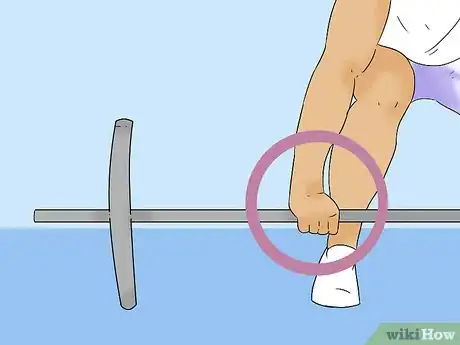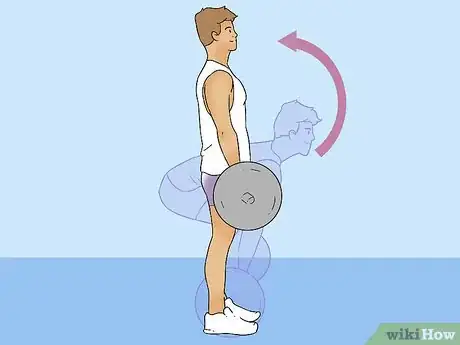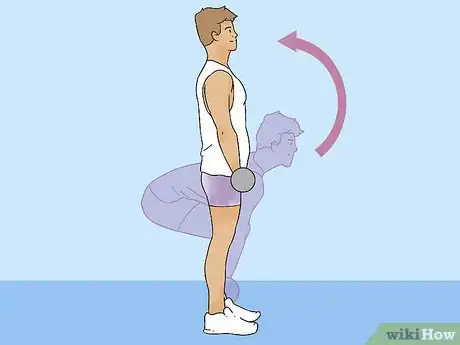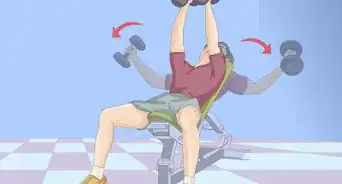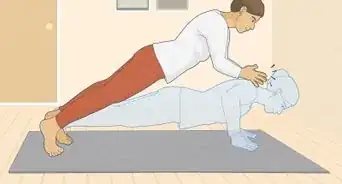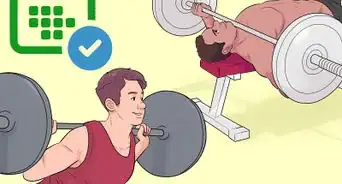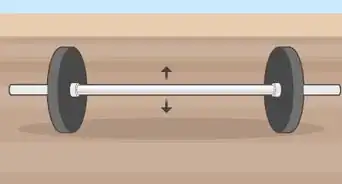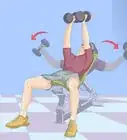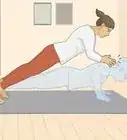This article was co-authored by Melody Sayers, MS, RD, NASM-CPT. Melody Sayers is a Registered Dietitian and NASM (National Academy of Sports Medicine) Certified Personal Trainer. She is the owner of Elevate Your Plate®, a private nutrition counseling and personal training practice, focused on an evidence-based, individualized, realistic, and results-driven approach to improving one's health. With over 8 years of experience, Melody has worked in both the private and public health sectors, helping both individuals and communities achieve milestones in managing their weight and preventing disease. She currently holds a Certificate in Adult Weight Management and a Master of Science in Nutrition, Dietetics, and Food Science from the California State University - Northridge.
wikiHow marks an article as reader-approved once it receives enough positive feedback. In this case, 90% of readers who voted found the article helpful, earning it our reader-approved status.
This article has been viewed 1,275,420 times.
The deadlift is an excellent compound exercise that targets the quads, hamstrings, gluteal muscles, lower back, traps, and forearms--not to mention it will make you feel like a beast when you do it. However, if not done properly, serious injury such as a herniated disc can occur. Follow these steps for the proper way to deadlift and turn into a modern day Hercules.
Steps
Setting Up for the Barbell Deadlift
-
1Prepare the barbell. Place the barbell on the ground in front of you and add plates according to your strength and fitness level. If it is your first time performing the deadlift, start lighter. It is always easy to add weight later. You want to perfect your form before you test your physical limits.
- Secure the plates tightly onto the barbell with clips to keep them from slipping around.
- Beginners usually start lifting just the barbell, since a typical barbell weighs between 25 and 45 pounds on its own. In this case, you'll want to prop the bar up so it's as high on your shins as it would be if it had plates (approximately 6-8 inches). Otherwise, you'll be bending too far down to pull the barbell right off the floor and could injure yourself. When you prop the barbell, be carefully that it can't easily roll off.
-
2Set your stance. Step up to the bar so that your feet are approximately shoulder width apart, your toes are pointing forward or slightly outward, and the barbell is at the midpoint of your foot (as if it's dividing the front and the back of your feet in half).Advertisement
-
3Sit back. Pretend there's a short stool behind you; bend your knees and hips and sit back as if you were going to sit on that stool, while you reach down to grab onto the barbell (hands shoulder-width apart). Actively push your knees out; don't let them collapse in. Keep your back straight so your spine is in a neutral position parallel to the floor. Hinge forward from your hips instead of bending from the waist. Bend your knees and hips just enough to reach and grab onto the bar. This is the starting position for the deadlift.
- Your shins should be pretty vertical and touching the bar.
- This is a hard position to stay in. As you figure out your form and check all these criteria, sometimes you'll straighten your legs and allow your back to curve to take a little break from this position. If you watch people deadlift, you'll see them do this between deadlifts. Just make sure you get back into this position before you actually lift.
-
4Check your grip. Grasp the barbell with your hands slightly more than shoulder width apart, just outside of your legs. Keep your arms straight. Your palms should face your body, and be equally far from the ends of the barbell.
- It's not uncommon for people to use a mixed grip as they move onto heavier weights, as it affords a stronger grip, but it's generally better to keep things simple as a beginner.
- For Olympic lifting, some people use the hook grip, which is more secure but is painful at first. It is similar to the overhand grip, except that instead of the thumb over the remaining fingers, it is hooked underneath them.
- The underhand grip alone is not recommended because it can lead to the rupture of bicep muscle and connecting tendons, especially in people who do not have full flexibility in the elbow joint.
Doing a Deadlift with a Barbell
-
1Set your starting position. "Setting" here means creating tension in your body while you're in the starting position so you use your muscles when you pull the bar up. It's a bit like clenching your body; you don't want to be like a wet noodle at all because then you might pull a muscle or hurt a joint.
- Always make sure your back is completely flat and straight. Keep your head, shoulders, and back in alignment. If there is any kind of bend in your back, you need to do some flexibility work before deadlifting. If you have someone record you in starting position, you'll be able to see whether your back is straight or not.
- Your hips should be above your knees and your shoulders should be above the hips while slightly over the bar.
- Engage your core and keep your weight heavy in your heels.
- Make sure you are looking at the ground in front of you (about 45 degrees) to avoid strain on your neck when performing the lifting portion of the deadlift.
-
2Stand up and bring the bar up with you. Raise your hips and shoulders at the same rate while maintaining a flat back. Keep your abs tight during the whole lift.
- Begin the movement by lifting the slack out of the bar. This is done by pulling the bar slightly up until you feel resistance. If you are using metal plates, you will hear a slight clanging noise. This engages all of the muscles prior to committing to the lift.
- Next, lift the weight while pushing through the middle of your foot, straightening your knees while pulling your shoulders and head back, and pushing your hips forward after the bar has reached just below the knee.
- The bar should drag along your shins on the way up--that's why a lot of people who deadlift wear pants or knee-high socks, and if they don't, they often have bruises or scrapes to show for it.
- Come to a standing position with upright posture and your shoulders pulled back (don't let your shoulders cave forward, think of always pinching your shoulders back together and sticking your chest up and out). Don't bend backwards at all, just stand up straight.
- Engage (squeeze) your hamstrings and glutes to pull the bar up.
- Avoid locking your knees.
-
3Lower the bar. Keeping your back straight, return the bar to the starting position in a controlled manner. Push your butt out as if you are going to sit down in a chair. Do not arch your back or curl your tailbone under.
- Release the weight after it is on the ground.
Doing a Deadlift with a Dumbbell
-
1Place two dumbbells on either side of your body. The dumbbells should be slightly in front of your feet. Make sure that the weight of your dumbbells is appropriate for your strength.
-
2Position yourself properly. Your feet should be spread slightly wider than your shoulders. Point your toes forward. You could also point them slightly outward; the result will be the same.[1]
-
3Squat down and grasp the dumbbells. You should squat with a flat, neutral back. Make sure that your shoulders are pulled away from your ears. Keep your head in line with your spine, though if it more comfortable you can tilt your chin up slightly. Make sure that your gaze remains straight ahead (if your eyes wander, so will your head, which will in turn shift your spine.) Make sure that your chest is lifted.
- Make sure that your heels stay firmly on the floor, and that your shoulders are slightly in front of the balls of your feet.
-
4Keep your core strong while you stand up. Your abs help stabilize your spine when you begin to lift the dumbbells. Straighten your knees and then your hips before coming to a fully upright position. Your elbows should be straight and the dumbbells should rest by your sides against your thighs.[2]
- Your hips and shoulders should rise up and straighten at the same time. You should try to keep the dumbbells as close to your body as possible while you straighten up.
-
5Hinge at the knees to lower the dumbbells back down. Your hips should move backwards and down as you begin to squat back down to the ground. Try to avoid bending your knees so that they are far ahead of your toes. Keep your back straight and avoid curling your tailbone in or arching your back.[3]
- Make sure to keep your abs strong and engaged while you lower back down. Keep your shoulders back and lowered while you do this lift and squat.
Community Q&A
-
QuestionWhat kind of injury can happen from deadlifting?
 KrystleCommunity AnswerThe most likely scenario is injuring your back by lifting too much weight with improper form. It's also possible to strain a muscle in the back, arms or legs.
KrystleCommunity AnswerThe most likely scenario is injuring your back by lifting too much weight with improper form. It's also possible to strain a muscle in the back, arms or legs. -
QuestionCan this help increase your vertical leap and posture?
 KrystleCommunity AnswerDeadlifting strengthens the posterior chain, which may help with your vertical leap, but there are other, more dynamic strength exercises that are better for that, such as the power clean. Deadlifts also help strengthen the lower back, if done correctly, which may help with posture.
KrystleCommunity AnswerDeadlifting strengthens the posterior chain, which may help with your vertical leap, but there are other, more dynamic strength exercises that are better for that, such as the power clean. Deadlifts also help strengthen the lower back, if done correctly, which may help with posture. -
QuestionWhat workouts can increase deadlift?
 Community AnswerSquatting, stairs, jump boxes, shrugs, shoulder complex sets, and any core exercises.
Community AnswerSquatting, stairs, jump boxes, shrugs, shoulder complex sets, and any core exercises.
Warnings
- In no section of the lift should you be exerting force with your upper body; this is not an upper body exercise. Your arms should merely act as connecting links between the bar and your shoulders.⧼thumbs_response⧽
- As with any other exercise advice, consult your doctor if you aren't sure you can handle a new exercise regimen.⧼thumbs_response⧽
- Beginning to deadlift at a weight too heavy for your body will cause serious injury. Attempting to lift too high of a weight increases the chances of injuring the body through improper muscle recruitment and overstretching of tendons and ligaments. This process also aids in the development of long-lasting dangerous deadlifting habits. Only increase load when you feel you are comfortable with your form at a particular weight.⧼thumbs_response⧽
- Never drop the bar. Always lower it in a controlled manner. Other than losing the benefit of that portion of the exercise (and making lots of noise in the gym), you risk crushing your shins if the bar suddenly rolls toward you because of the drop or a slope on the gym floor.⧼thumbs_response⧽
- If your back begins to bend during a lift, stop! Put the bar down and use lower weights.⧼thumbs_response⧽
Things You'll Need
- Barbell and weights
- A lifting platform
- Dumbbells
- Shoes with a flat sole
- Comfortable Athletic clothing (T-shirt or tank-top, athletic shorts that lie above the knee)
- Water
- Chalk (optional)
- Knee-high socks (optional)
- Spotter
- Lifting belt (optional)
References
- ↑ http://www.acefitness.org/acefit/fitness_programs_exercise_library_details.aspx?exerciseid=20
- ↑ http://www.acefitness.org/acefit/fitness_programs_exercise_library_details.aspx?exerciseid=20
- ↑ http://www.acefitness.org/acefit/fitness_programs_exercise_library_details.aspx?exerciseid=20
- Videos provided by intosport
About This Article
Before you do a deadlift with a barbell, place the barbell on the ground in front of you and adjust the weights according to your strength and fitness level. Stand with your feet shoulder-width apart with your toes pointing forward. Reach down to grab the barbell, sitting back as you do so. Push your knees out and keep your back straight. Stand up and bring the bar up with you, keeping your abs tight and your back straight, then lower the bar again, sitting back once more. Read on to learn how to do a deadlift with a dumbbell!



